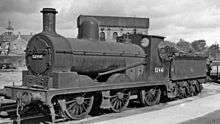Footplate
The footplate of a steam locomotive is a large metal plate that rests on top of the frames and is normally covered with wooden floorboards. It is usually the full width of the locomotive and extends from the front of the cab to the rear of cab or coal bunker just above the buffer beam. The boiler, the cab, and other superstructure elements are in turn mounted on the footplate. The footplate does extend beyond the front of the cab on some locomotives, but is then usually referred to as the "running board/plate." The footplate is where the Driver and Fireman stand in the cab to operate the locomotive, giving rise to the expression of working on the footplate[1] for being in the cab of a steam locomotive. The part of the footplate ahead of the cab is referred to by a variety of different names.
In the modern age, although the steam locomotive has been phased out, the word footplate remains current coin. It is used to describe the act of travelling inside the cab of a (diesel or electric) locomotive, and in this context to the cab itself also. Thus : "when the General Manager travels on a train, an engineer must be present on the footplate" or "an engineer footplated the locomotive after trouble in its bogies was reported at an intermediate station". However, in most varieties of English the word is not used to refer to the cab outside the context of someone riding in it. The term footplate can also be applied to the step along the length of a classical tram on both sides.
National variations
The presence of a footplate is almost universal in British locomotive construction, is often (but not universally) seen in continental European locomotives, and practically never on locomotives constructed in the United States. American practice mounted the locomotive's boiler and cab directly on the frame.[2] The walkways and running boards seen on American locomotives that sometimes give an appearance of a footplate are attached to the boiler or the pilot and are not structural elements. The absence of a footplate on American locomotives is one thing that makes them look "not quite right" to those accustomed to the British look.
Details
The footplate has openings cut in it for various purposes. The firebox always extends beneath the footplate. The cylinders are beneath the footplate, and steam pipes pass through holes to them. The reversing gear control for the valve gear also passes through, and in some locomotives part of the valve motion also extends through the footplate.

On British Railways Standard Locomotives the running plate was high enough to clear the wheels. On earlier British locomotives, the tops of the wheels usually projected through slots in the running plate and were covered by "splashers" which are analogous to mudguards on a road vehicle.
See also
References
- Harrington, Ralph (26 March 2007). "Perceptions of the locomotive driver:image and identity on British railways". York University. Archived from the original on 10 September 2007.
- Walker, Herbet T. (1 May 1897). "The Evolution of the American Locomotive". Scientific American Supplement (Part 2 of 3). Retrieved 26 March 2007 – via (transcription) Catskill Archive.